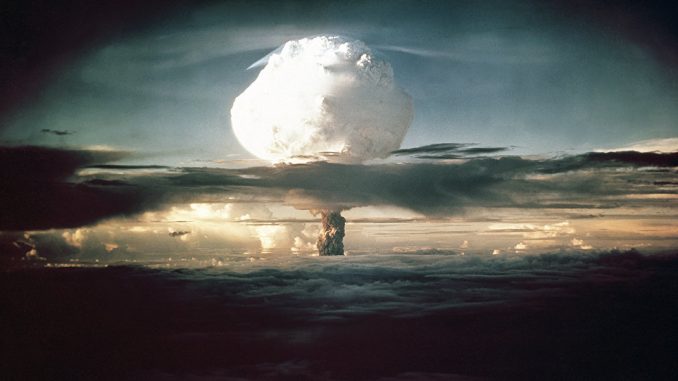
A concrete dome holding radioactive waste of 42 nuclear explosions is leaking into the pacific ocean, veterans have warned.
The Enewetak Atoll was used by the US government to test 30 megatons of weapons – equivalent to 2,000 Hiroshima blasts – in the 1950’s.

BYPASS THE CENSORS
Sign up to get unfiltered news delivered straight to your inbox.
You can unsubscribe any time. By subscribing you agree to our Terms of Use
Latest Video
Express.co.uk reports: More than 8,000 people would later work to clean up these Pacific islands, shifting 110,000 cubic yards of contaminated soil and debris into a blast crater.
This 30-feet-deep crater on Runit Island would then be entombed in a concrete dome, 350 feet across and 16 inches thick.
But now, with the dome weathered by decades of exposure, it’s feared that rising seas and storms could see radiation leaking into the ocean.
Paul Griego, who took part in the cleanup and blames the radiation for a host of health problems, said the dome was never fit for purpose.
He said: “We were given an impossible task – cleaning up the radioactive fallout from 43 nuclear bombs.
“When I first arrived, the dome’s blast crater was open to the ocean – it continued to be full of sea water even after it was sealed off from the ocean.
“During my 10-hour work day I witnessed the water level in the crater rise and lower as the tide came in and out.”
He continued: “No attempt was made to drain the crater or line it before the radioactive waste was dumped into it.
“The coral that created the island is porous and the shock from numerous nuclear weapon tests had also fractured the coral.
“From the first day forward, the water has flowed out of the lagoon with the tide, creating a gigantic radioactive toilet that is flushed about twice each day into the Pacific Ocean.”
The storms were only making matters worse, he said.
“I experienced the power of a typhoon while I was on Enewetak,” he added.
“I believe the dome could be just one typhoon away from a breach.”
Rama Schneider, who drove radioactive waste from island to island in an amphibious vehicle during the cleanup, said it was no surprise that the dome was failing.
He said: “Standing on any island at that atoll is akin to standing inches above sea level – and that was in 1979.
“The sea level and ground level are becoming more and more to be the same, and it doesn’t matter if we’re talking sea level rise, land subsidence or both.
“Water will always win out over man-made objects.”
Girard Frank Bolton III, who worked as a draughtsman during his 14 months on the atoll and drew the construction documents for the dome, insisted the damage to the structure was minimal.
Yet he agreed that radiation was nonetheless being washed out of the crater, into the lagoon and ultimately, into the ocean.
“The dome was designed to slow the migration of radiation not to completely stop it,” he said.
“Also, since concrete is porous, the wave action and tides are continuously pumping radioactive water in and out of the structure.”
Now the veterans are pushing the US government to help with their radiation-related health woes.
It’s clear that workers were given inadequate protection from photos of the cleanup, which show them labouring shirtless and with basic tools.
Mr Griego, from Albuquerque, New Mexico, says chronic intestinal disease, beryllium poisoning, weak bones and fertility issues are among the legacies of his service.
“The entire time I was there I never saw anyone wearing a hazmat suit,” he said.
“We were not provided any radiation safety gear – not even a pair of ordinary garden gloves – and we collected the toxic soil samples mostly with our bare hands.”
He continued: “With reasonable certainty we believe the failed mission has already taken the lives of thousands of the atomic cleanup workers.
“Within our survivor group we lose six to eight men each year to cancer and other radiation-related illnesses.”
Mr Bolton, from Mobile, Alabama, blames the radiation for his arthritis, calcium bone loss, Barrett’s oesophagus, diverticular disease, high blood pressure, and neuropathy.
He added: “Of our 8,033 mission participants, only 600 have been accounted for.
“35 of those are deceased, 11 died after our group was founded and about half of our group believe we have health challenges from our mission at Enewetak Atoll.”
Experts agree that the degree of danger posed by the Enewetak radiation is dependent on how much escapes and is ingested.
Professor Francis Livens of the University of Manchester’s Dalton Nuclear Institute said that a number of factors, such as the radiation being dispersed, could mean the hazard is low.
“But if radioactivity is efficiently released and transported into food or water, or gives rise to exposure by some other means, then the hazard is relatively high,” he continued.
Professor Patrick Regan, a radiation expert with the University of Surrey, said the main health risk was likely to be stochastic – meaning an increase in one’s lifetime risk of developing a cancer.
“The units we used for radiation exposure are called sieverts,” he said.
“One sievert across the whole body won’t kill you but it will give you radiation syndrome.
“It’s supposed to increase your biological risk of getting cancer by about 5 per cent.”
However, he added, it would be impossible to tell whose cancer developed because of their exposure and whose would have developed anyway.
“The problem is that you cannot differentiate those people from the rest of the population,” he said.
“You cannot say that there are this many people, that many of them would get cancer anyway and one additional one would get cancer because of their exposure – because you couldn’t tell which one it was.”


